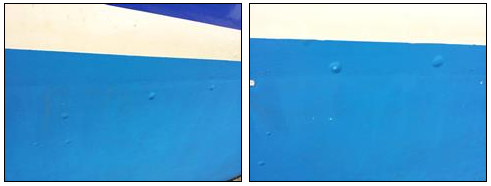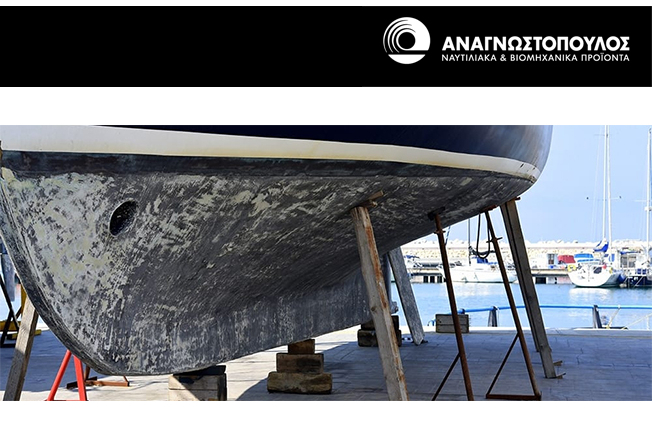Osmosis of Polyester Boats
WHAT IS OSMOSIS?
Osmosis is a phenomenon of natural aging polyester. It develops slowly and may appear as small blisters (size of a pinhead) after a few years. All polyester boats may face this phenomenon.

UNDERSTANDING OSMOSIS:
Water is soaking in the polyester and it will destroy the resin.The boat becomes soft and is likely to decompose.Osmosis isdirectly related to the components that go into the manufacture of a polyester hull: the acid and the alcohol.This mixture which is added to the fiberglass may change from viscous to solid state with the help of a catalyser.Upon completion of this mixture, sometimes strands of glass fibers are mixed into the resin without being fully impregnated with the catalyst or the chemical reaction is incomplete.This creates small cavities in the structure of the hull, filled with a highly concentrated liquid, composed of acid and impurities. This liquid is neutral unless it is through contact with water.Natural osmosis is the imbalance between two liquids of different concentrations separated by a semipermeable membrane. The slightest concentrated liquid passes through the membrane to go to the most concentrated.On a boat, there is one light-concentrated liquid (water) and one high-concentrated liquid (in the boat’s structure) which are separated by a semi-permeable membrane: the gelcoat.The concentrated liquidcontained in the hull (which is in contact with water that has passed through the gelcoat) makes chemical reaction (hydrolysis) and will be changed in acetic acid, whilst increasing the volume. With a modern good quality,waterproof gelcoat, the water, which has penetrated the gelcoat by osmosis, and which is likewise converted into acetic acid (in reaction with the liquid contained by the polyester) cannot leave. This increases the volume appearing as blisters.The blisters are filled with acetic acid identifiable by their distinctive vinegary smell (it comes out when pierced.) This also explains why, with an old porous gelcoat, there are no blisters, hydrolysis still occurs, the acid is still created but, instead of causing blisters, it passes back through the gelcoat.
OTHER WARNING SIGNS:
- Blisters:Blisters can vary from smallpinhead blisters to areas aslarge as the palm of a hand.The presence of any fluidbehind a blister indicatesa potential problem.
- Star crazing:This effect can occur wherethe gelcoat is brittle. Finecracks usually form dueto severe flexing or impactdamage, allowing waterto seep into the laminate.
- Pinholes:Tiny holes present in the gelcoat reduce itseffectiveness and promoterapid water absorption.
OSMOSIS TREATMENT:
Preventing osmosis consists in creation of a waterproof barrier between the resin and the water. For this, we use an epoxy resin. On a new boat, it is possible to provide this treatment before the first launch. On a boat that has already sailed, ensure that the hull to be completely dried and not to trap moisture behind the epoxy barrier.
On a boat which contains moisture, it is necessary to remove the gelcoat (by planning), to dry the boat (sometimes several months) and then redo it including the epoxy barrier.
NAUTIX SYSTEM:

- Substrate preparation: Gel plane peeling or polyester grit blasting to abrade surface prior to treatment. Rinsingwith fresh water & drying of laminate. Repeat it to ensure removal of any unwanted (salt, soluble residue) and moisture. Drying of laminate with adapted system depending on location and season: ventilation, air flow. Keep readings of Temperature/Humiditysystem records by checking systematically above and below the waterline. Before starting the treatment, be sure humidity rate of the hull is no greater than 5% to the rate above the waterline.
- Sealing the substrate with IMPREGARD (solvent-free epoxy resin for impregnation): Applythe 1stthick layer by brush or roller. Once dried: Sand the surface with grit P80 to lop the ends of fiberglass which go beyond the surface by “wick effect”.Apply the 2ndlayer by roller and ensure the fiberis fully coated with resin.
- EPOXYGARD (protective epoxy primer): Apply 1layer.
- Filling with epoxy fillers (WATERTIGHT or BLUE FILLER):Application of filler is optional: depending on importance of surface imperfection.
- Protection & finishing with EPOXYGARD (protective epoxy primer): Apply 4 -6 layers (depending on thickness).Respect overcoating time between layers to allow good evaporation of solvents.
- Nautix antifouling: Apply 2 layers.







